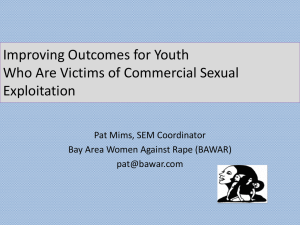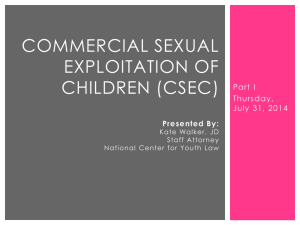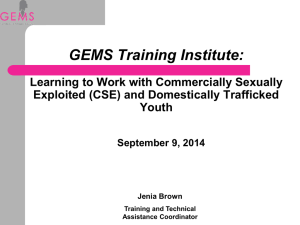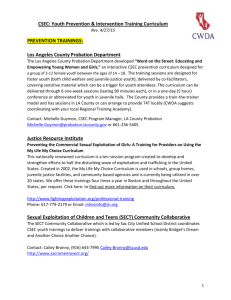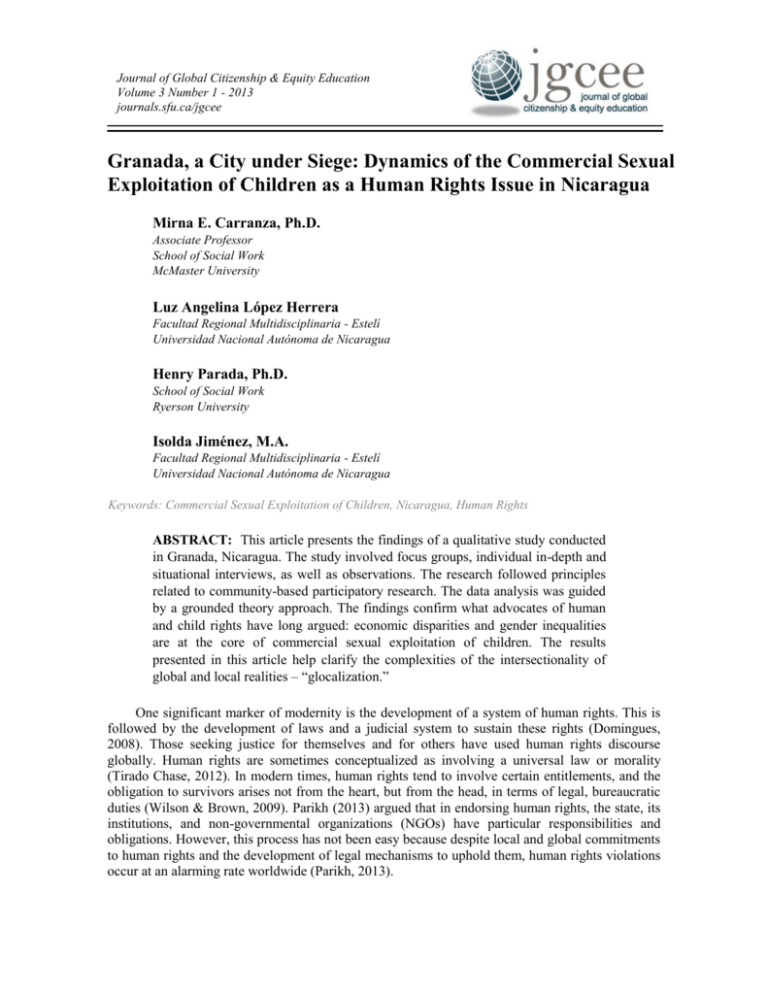
Journal of Global Citizenship & Equity Education
Volume 3 Number 1 - 2013
journals.sfu.ca/jgcee
Granada, a City under Siege: Dynamics of the Commercial Sexual
Exploitation of Children as a Human Rights Issue in Nicaragua
Mirna E. Carranza, Ph.D.
Associate Professor
School of Social Work
McMaster University
Luz Angelina López Herrera
Facultad Regional Multidisciplinaria - Estelí
Universidad Nacional Autónoma de Nicaragua
Henry Parada, Ph.D.
School of Social Work
Ryerson University
Isolda Jiménez, M.A.
Facultad Regional Multidisciplinaria - Estelí
Universidad Nacional Autónoma de Nicaragua
Keywords: Commercial Sexual Exploitation of Children, Nicaragua, Human Rights
ABSTRACT: This article presents the findings of a qualitative study conducted
in Granada, Nicaragua. The study involved focus groups, individual in-depth and
situational interviews, as well as observations. The research followed principles
related to community-based participatory research. The data analysis was guided
by a grounded theory approach. The findings confirm what advocates of human
and child rights have long argued: economic disparities and gender inequalities
are at the core of commercial sexual exploitation of children. The results
presented in this article help clarify the complexities of the intersectionality of
global and local realities – “glocalization.”
One significant marker of modernity is the development of a system of human rights. This is
followed by the development of laws and a judicial system to sustain these rights (Domingues,
2008). Those seeking justice for themselves and for others have used human rights discourse
globally. Human rights are sometimes conceptualized as involving a universal law or morality
(Tirado Chase, 2012). In modern times, human rights tend to involve certain entitlements, and the
obligation to survivors arises not from the heart, but from the head, in terms of legal, bureaucratic
duties (Wilson & Brown, 2009). Parikh (2013) argued that in endorsing human rights, the state, its
institutions, and non-governmental organizations (NGOs) have particular responsibilities and
obligations. However, this process has not been easy because despite local and global commitments
to human rights and the development of legal mechanisms to uphold them, human rights violations
occur at an alarming rate worldwide (Parikh, 2013).
JGCEE, Vol. 2, No. 2, October 2013 • 154
The commercial sexual exploitation of children (CSEC) is an extreme violation of human
rights (Phinney, 2001; Save the Children, 2007). While most countries have signed or ratified the
United Nations’ Protocol to Prevent, Suppress and Punish Trafficking in Persons, Especially
Women and Children, CSEC continues to be a major problem globally (Guinn, 2008). This paper
presents research about CSEC conducted in Nicaragua. Nicaragua signed the Convention of the
Rights of the Child in February 1990 and ratified it in October 1990 (Gutierrez, 2007). Shortly
after, the country made relevant amendments to its constitution. For example, in 1992 an
amendment to the penal code prohibited the trafficking of persons and made specific reference to
the protection of children against any form of economic and social exploitation (Constitución
Política de la Republica de Nicaragua, Art # 84). In addition, Executive Decree No. 116-2000 gave
rise to the National Commission on Violence against Women, Children, and Adolescents; this
Commission is mandated to develop an annual national action plan to address this issue (Ley de
Organización del Consejo Nacional de Atención y Protección Integral a la Niñez y la Adolescencia
y la Defensoría de las Niñas, Niños y Adolescentes, 2000). Our research investigated the
experiences and perceptions among the general population of Granada, Nicaragua, in order to
clarify the local realities shaping CSEC in this country.
This article begins with a brief literature review regarding CSEC in Central America. It
focuses particularly on the invisibility of perpetrators, demand for CSEC, and the perceived
tolerance of this social phenomenon. The literature review is followed by a brief contextualization
of Nicaragua. The next sections outline the methods and the findings, specifically the complexities
of CSEC in terms of its public nature and the intersection of globalization and local realities, such
as cooperation between local networks that act as suppliers of vulnerable children and as abettors of
such illicit activities. A discussion of the findings follows.
Commercial Sexual Exploitation of Children (CSEC) in Central America
Global responses from governments, law enforcement, and NGOs have resulted in increased
prosecution of sexual trafficking charges when children and adolescents are victimized. However,
CSEC is still a major problem in many regions of the world, including Central America (Beare,
2003; End Child Prostitution and Trafficking (ECPAT), 2000). One barrier faced by researchers
trying to understand this social problem in Central America is the scarcity of local information
about its nature and incidence, despite evidence of CSEC in the area. Moreover, although an
increasing body of literature has focused on the structural inequalities at the core of global sex trade
industry, including global economic disparities, the prevalence of violence against women and
children, gender inequality, heterosexism, and racism (Azaola & Estes, 2003; Ellsberg, 2005;
Flisher, 2005; Marshall & Thatun, 2005; Matibag, 2003; Organization of American States (OAS),
2007; O’Connell, 2001; Torres-Saillant, 2006; Voss, 1999), little is known about how local realities
intersect with structural global issues to shape the nature of CSEC in specific Central American
countries (Sanghera, 2005). Therefore, careful examination is needed of the specific features
affecting the incidence of CSEC in the context of local realities in each country (Carranza &
Parada, 2010). The dynamics of child exploitation in Central American countries are comparatively
different from those in other regions, so it is important to examine these specificities empirically
(Chun & Uck Lin, 2004; Jeffrey, 2002; O’Connell, 2005). This study was conducted to address this
research gap.
Granada, a City under Siege • 155
Invisibility of the Perpetrator
Chiarotti (2003) argued that too much emphasis is placed on survivors of CSEC, and that this
emphasis invisibilizes the perpetrator. For example, South American tabloids often portray police
forces raiding brothels and nightclubs and detaining women and children who have been sexually
exploited, rather than focusing on the traffickers (Rodriguez, 1999). Although the focus should be
on the demand for CSEC, and the perpetrators of CSEC, blame also tends to fall on the survivors.
Dimenstein (1994), for example, reported that Brazilian police would reputedly demand free sex
from young girls involved in sex work by threatening to blackmail them should they fail to comply.
The results of the present study will help clarify some of the factors related to CSEC, specifically
the processes of cooperation within the network providing supply to meet demand, rather than
focusing on the children involved in CSEC.
Tolerance/Apathy about CSEC
In Latin America, CSEC crimes often go unaddressed due to silence among the general
population and corruption among government officials at all levels (Molina, 2008). Additionally,
regional initiatives by academics, NGOs, and the private sector are still in their infancy in terms of
raising awareness about this phenomenon limiting each country’s ability to understand, prevent,
and penalize CSEC (III-Latin American Congress on Human Trafficking (III-LACHT), 2012). The
Organización Internacional del Trabajo (OIT) (2005 & 2009) reported that the general population in
Central America became significantly more tolerant of crimes related to CSEC between 2005 and
2009. Furthermore, the United Nations Children’s Fund (UNICEF) - America Latina & the
Caribbean (2005) conducted a study about CSEC in the Caribbean and Latin America, and found
that when this kind of crime is reported, accusations by survivors or bystanders are often not
believed. The results of the present study will help clarify the nuances of tolerance about CSEC in
Nicaragua, particularly in Granada.
Nicaragua’s Context
From 1990–2006, neo-liberal policies led to a massive deterioration of Nicaragua’s economy
(Ocampo, 2011). Despite the country’s efforts, such as the new social policies to improve the lives
of citizens, in 2013 Nicaragua was deemed the second poorest country in Latin America (United
Nations Development Programme (UNDP), 2013). In 2007, Nicaragua’s total population was
5,142,098: 50.7% women and 49.3% men. Overall, 55.9% of Nicaraguans live in urban dwellings
and 44.1% live in rural areas; 67% of the total population in Nicaragua is aged 25 years or younger;
79% of the total population lives on less than US$2.00 dollars per day and 45% on less than
US$1.00 per day (Conferencias Internacionales de Educación de Adultos VI (CONFINTEA VI),
2008). In 2007, 2,089,773 (40.6%) Nicaraguans were employed (756, 294 in the formal sector and
1,333,479 in the informal sector). Although Nicaragua’s judicial system specifies the protection of
children against child labour, 265,881 children and adolescents (13. 4% of the total work force)
were working in the informal sector in 2006. Significant gender inequalities appear, as men tend to
receive salaries, while women tend to be employed in small family businesses (CONFINTEA VI,
2008). According to the Plan Nacional de Desarrollo Humano (PNDH) (2010), Nicaragua
experienced a 2% decline in human development among girls in 2009.
Nicaraguans have used migration to neighbouring countries or the United States and tourism
to escape poverty. In 2000, 20% of the total population migrated to another country, particularly
Costa Rica. More than 75% of the 300,000 registered immigrants in Costa Rica were of Nicaraguan
JGCEE, Vol. 2, No. 2, October 2013 • 156
origin; this number is the equivalent to 8% of the total population in Costa Rica (Villa & Martinez,
2001). Nicaragua has the highest migration rate of women in Latin America (Mahler & Ugrina,
2006). In 2011, remittances from immigrants totalled US$905.1 million, a 29.8% increase from
2006 (PNDH, 2012, p. 19). Tourism is Nicaragua’s best resource in terms of economic
development. In 2008, the country received more than one million tourists, a 25.41% increase from
2007. In 2011, revenue from tourism was US$377.1 million US, a 22.2% increase from 2010. In
2011, foreign investment was US$967.9 million, a 90.5% increase from 2008 (PNDH, 2012).
Granada. The city of Granada (the site of the research presented here) has an estimated
population of over 110,000, making it Nicaragua’s fourth largest city. It is advertised as an ideal
retirement place (see www.topretirements.com). As in many other colonial cities in Latin America,
its downtown core has a central plaza and other important city buildings. These buildings have
recently been remodelled to encourage tourism. In our initial community consultations Granada
emerged as a suspected site of CSEC due to the high incidence of tourism.
Violence against women is an ongoing problem in Nicaragua. In 2011, 37,000 cases of sexual
violence were reported (Riddell, 2012). On June 22, 2012, the current Nicaraguan government
passed law #779, which criminalizes violence against women. Since then, 85 feminicides have been
reported, with only 27 arrests and four prison sentences (Carlsen, 2013). Nicaragua has an antiabortion law, which includes therapeutic abortion after sexual violence, thus rape survivors are
forced to carry high-risk pregnancies. In 2011, 1,453 births were reported among children and
adolescents aged 10–14 years, but none of these were investigated (Riddell, 2012). There is a high
possibility that these births are related to CSEC.
The Study
A qualitative research methodology was selected to investigate the experiences of, and
perceptions about, CSEC among the general population of Granada. Data was collected through
focus groups (Krueger & Casey, 2009), in-depth and situational interviews (Denzin & Lincoln,
2005), and observations (Spencer & Davies, 2010). Together, this data helped clarify the multilayered meanings of complex concepts (Gilgun, Daly, & Handel, 1992) and allowed in-depth
analysis of participants’ lived experiences and the socially constructed reality within which they
were situated (Marshall & Rossman, 1995; Strauss & Corbin, 1990, 1994).
During data collection and analysis, the research team tried to remain aware of the power
imbalances between researchers and participants (Hollway, 2001). A critical step in addressing
power imbalances is to view qualitative research as a process that may be used to further the social
agendas and resilience of disempowered groups (Ungar, 2003; Ungar & Nichol, 2000). To this end,
we applied the principles of community-based participatory research (CBPR) (Minkler &
Wallerstein, 2002): (i) genuine partnerships, (ii) research efforts that include capacity building, (iii)
findings and knowledge to benefit all partners, and (iv) long-term commitments to effectively
reduce disparities (Israel et al., 2003). The present study is the product of previous and ongoing
relationships among academic organizations, NGOs, and government institutions in Canada and
Nicaragua funded by SSHRC – International Opportunity Grant (Carranza et al., 2008).
Recruitment
Given the sensitivity of the research topic, recruitment was carefully planned. We conducted
initial consultations with key community leaders. This was followed with town hall meetings with
community stakeholders. This community engagement was important in the development of a
Granada, a City under Siege • 157
community-based research advisory group (CBRAG), which was pivotal in providing feedback
throughout the study. This group also provided essential feedback about the initial interview guides
and supported the team in the direction of the project (e.g., recruitment strategies and local
observations).
Participants’ Description
We had a total of 72 participants: 50 females and 22 males. We conducted eight focus groups
with some participants (N=48; 32 females and 16 males), including employees at government
institutions, NGOs, human rights advocates, community leaders, adolescents at risk (13–17 years),
youth at risk (18–27 years), parents of children and adolescents at risk, media, and parents in
general. We also conducted 12 individual in-depth interviews (7 females and 5 males) with
adolescents, community leaders, and family members of children involved in CSEC. An additional
12 situational interviews were carried out (11 females and 1 male), with community neighbours,
street vendors, doormen, and business administrators. Situational interviews refer to those that were
carried out in the moment and without previous arrangement.
Data Analysis
We applied the principles of grounded theory (GT): data was systematically gathered and
analyzed using a “bottom up” strategy involving theme analysis (Charmaz, 2005). The process of
data gathering and analysis was recursive. Data analysis began after the first few interviews, and the
results of this analysis informed the direction of subsequent interviews (Patton, 2001).
Transcriptions were entered into NVivo9, computer software for managing and analyzing
qualitative data (Bazeley & Richards, 2000). As concepts were constructed and themes were
identified in the analytical process, they were compared, contrasted, and grouped following the
open coding procedure described by Strauss and Corbin (1990). Axial coding was also employed to
construct conceptual schemas that reflected the relationship between categories. During this
process, categories were changed, dropped, and organized hierarchically, and each was
simultaneously related to its context (LaRossa, 2005). Each research team member carried a journal
to record and systematize emergent themes, and regularly checked with each other about the themes
that were emerging. The goals were to seek alternative explanations, to identify and account for
disconfirming cases, and to ensure the quality of the data analysis (Seale, 1999).
Findings
This section begins by discussing the locations in the city of Granada identified by participants
as having high incidences of CSEC. Second, it presents the research team’s observations, and
finally describes the themes that emerged in the data analysis as most significant: (i) the
supply/network of CSEC, and (ii) the intersection of globalization and local realities, or
“glocalization.”
The Presence of CSEC
Locations were initially identified and mapped via initial community consultations.
Participants in focus groups, individual interviews, and situational interviews later confirmed these
locations. Participants reported several locations where CSEC could be observed, especially at
night, in areas associated with the tourist sector such as the Zona Central (downtown), la Calle
(street) de la Calzada, the central park (near the main Catholic cathedral), a corner near the local
bank, and an area with many bars.
JGCEE, Vol. 2, No. 2, October 2013 • 158
Participants said that the Calzada has been developed in recent years to attract tourists, with
outdoor cafes, music, and European-style restaurants ready to welcome visiting nationals and
foreign tourists. They said that most of these cafes and restaurants and the like are “equipped” to
provide “combo” services: a female child or adolescent, drinks, drugs, a room, and a boy.
According to participants, a teenage boy is placed outside the room for two reasons: (i) to ensure
the safety of the male customer; and (ii) to ensure the child delivers the sexual favours in
accordance with the verbal contract and payment received.
Other locations reported included: la Calle de la Karaguala, the beach at the lake, exits and
entrances to the main highways, and barrios (neighbourhoods):
If you go to the highway or main entrance to Granada coming from
Managua, you see a lot of them there. Or if you go to certain barrios, they’re
there…you see them in the open.
Interviewees were highly aware of the locations where CSEC occurred; these appeared to be
common knowledge.
Observations
Prior to data collection, the research team visited Granada several times for community
consultations through town hall meetings and observations; these were conducted at various
timeframes: weekends/weekdays, daytime/night time, and holidays/workdays.
The team spent some time in Granada during the hipica, a week-long cultural celebration
rooted in Catholicism. Many cultural events take place during the day, including traditional dances
and horse races, and at night time the cafés are full of customers. The research team was able to
observe many adult and/or elderly Caucasian, Black, and, what appeared to be, Nicaraguan men
accompanied by female teenagers, who generally appeared to be 13–17 years old. Each man and the
accompanying adolescent would be served food and beer. After a period of time, they would walk
toward the rear, enter a back door, and disappear. They appeared to be accompanied by a male
teenager at all times.
The research team also observed a teenage boy and one or two female adolescents walking
back and forth on the Calzada. On other occasions, boys would arrive with one or two adolescent
girls and talk with someone in the restaurant, usually a waiter, sit down at a table, and minutes later
a Caucasian man would sit down with them. Sometimes they would eat together; other times they
would talk for a couple of minutes and then walk up or down the Calzada or disappear down the
street, near the local bank.
Other activities were observed further down the Calzada, by the central park, while children
and teenagers were performing a dance for an audience of at least 70 people. In the shadows and at
the margins of this public activity were groups of female adolescents (approximately 13–15 years
old). A man accompanied by a local teenage boy would arrive and the girls would leave one at a
time, while the teenage boy stayed. Approximately an hour and half later, the girls would come
back and slip something into the boy’s hand.
Granada, a City under Siege • 159
On other occasions, the team witnessed, several times, young Caucasian men (approximately
30–35 years old) calling, “Cuanto?” (How much?) to female adolescents walking home from
school in their uniforms. The girls would look at each other and walk much faster, trying to get
away from the foreign men. These types of interactions were carried out in public, in broad
daylight.
The team noted a decrease in these public activities while conducting observations on
workdays. However, on holidays the scenarios described above would recur; the number of locals
participating in celebrations appeared to decrease, and fewer Nicaraguan male tourists were
observed.
The Supply: Network of CSEC
Respondents said that some adolescents get involved in CSEC on their own accord and/or as a
group endeavour, while others are involved in a more complex network. A street vendor
commented:
They see a man and say, ‘Oye Amigo sexo normal for $40.00’ [Hey friend,
normal sex for US$40.00]. Other say, ‘20.00 Córdobas por un rato’ [A bit of
time for 20 Cordovas]. Other say, ‘US$150 room included….Of course they
charge more to the gringos [White men] and the foreigners. However, when
they are in a group of three or four, they make the offer to the gringo. The
gringo takes a look at their body and then says, ‘You,’ and then she names
her price…
Other respondents said that Granada has a working network with a clear distribution of tasks
and responsibilities. One adolescent said:
There are older people, men and women that get men for them. They [adults]
get the money and then they give the money to the chavalas [female
adolescents]. Also there are other chavalas that walk with chavalos [male
adolescents] and the chavalos look for the men…like they do the conecte
[link]…The men ask the chavalos, ‘Hey tenes chavalas?’ [Hey Do you have
teenage girls?]. So… you see the chavalos walking up and down the Calzada
asking men, ‘Do you want a chavala?’... Also taxi drivers look for clients
and then they go to get them [adolescents] and say, ‘Let’s go I have a client
for you’… They have specific hotels where they go to …
A government employee commented:
They [adults] offer them money. Other adolescents that are involved in it,
too. They [adults] tell them that there is money in that…They have a red
[network], when a man asks for a chavala, they call her and say, ‘there is
someone waiting for you in such and such a place’…The waiters are
involved… they allow the chavalas to come into the restaurant. They tell
them to what hotel to go. They call the taxi driver that they know…
The network sustaining CSEC in Granada is complex. Our results reveal a high level of
awareness about the existing networks and perpetrators involved in CSEC. The government
employee’s comment had undertones of fear and frustration, while the adolescent’s comment
JGCEE, Vol. 2, No. 2, October 2013 • 160
reflected a sense of amusement; she described the situation in a matter-of-fact way. It is noteworthy
that the open communication in the exchanges described in the excerpts appears to be common
knowledge, and part of ordinary life.
CSEC: Intersection of Globalization and Local Realities – Glocalization
Respondents said that various forms of CSEC took place in Granada, such as child
pornography, trafficking children to other cities for the purpose of CSEC, and one-time or regular
customers.
There was a foreigner here that was sexually abusing the children. He would
make videos; take photos in a local lodging place. There were a lot of
children involved; the owner of the place would see that as if there wasn’t
anything wrong with it. [Community leader]
We know there is trafficking in children here. They offer them a kind of a
job. Once they get there, they realize it was for prostitution. They had them
like incarcerated them and told them, ‘I fed you, you have to pay me now.’
That debt goes on forever… [Government institution employee]
Demand
Participants reported that demand for CSEC in Granada comes from different sources: men
from Managua, Masaya, León, locals, and foreigners. They said that when the men involved in
CSEC are locals or nationals, they are usually older; i.e., middle-aged, and come from high social
strata. This means they have the financial resources to spend on illicit activities involving CSEC.
According to our respondents, these men are usually married and “bored with their wives,” and
seek out sexual favours from female children and adolescents to “entertain themselves,” but
respondents also stressed that they considered these actions to be disrespectful to the men’s wives.
Respondents said that foreigners accessing CSEC also tend to be middle-aged men who come
to Granada as tourists regularly or sporadically. They also referred to some foreigners who have
moved to Granada permanently, and are involved in CSEC:
There is a kid that has a gringo [White man] as a boyfriend. He went to the
house and asked for the mother’s permission [consent] para jalar con ella
[date her]. But that is not dating. He is an old man and she is a chavala
[child]… I would have never agreed to that. That man takes her to
Managua. They stay there for a couple of days there, doing who know
what. [Mother #1]
There are several kids that jalan [date] gringos and you see them holding
hands. Sometimes, the gringo [White man] even chooses which child he
wants. Yes, yes, it would be nice if one of these gringos married one of
them and took them away from all of these, you see cases like that. There
was one that I know married the gringo and now she sends reales [money]
to her mother. That is pretty… [Community Leader]
Granada, a City under Siege • 161
Although demand for CSEC comes from both nationals and foreigners, respondents said that
foreigners who have moved to Granada permanently have contributed to a higher incidence of
CSEC. Interestingly, respondents tended to blame the children and their parents, rather than the
men soliciting sexual favours from children; this invisibilizes the demand and the embedded power
dynamics of the perpetrator.
Additionally, foreign men appear to use Nicaraguan cultural traditions such as asking for a
parent’s permission to date their daughter, as strategies to legitimize their illicit actions. In
Nicaraguan culture, asking parental permission to date a female adolescent indicates a suitor’s good
intentions, i.e., eventual marriage. Parents may also hope that a foreigner will take the child away
from poverty and into a better life, which in turn might bring financial benefit to the family; if so,
this would help illustrate the mercantile nature of CSEC.
The Myth of Tolerance of CSEC
Our data suggest that the social construct of “tolerance to CSEC” is situated within a complex
process involving tensions, frustration, fear of retaliation from those involved in CSEC, fear of
social stigma among survivors, helplessness due to the extreme poverty in which most children and
adolescents in Granada live, perceiving reporting CSEC as a “waste of time,” lack of knowledge or
sensitivity, and most importantly desensitization to the issue, leading to the perception of it as
“normal” among the general population and local authorities. Our respondents made comments
such as: “If I report it, she is just going to turn back, so why bother,” and “You call the police and
nothing is done.” Other comments included:
I think is fear … the children get attacked on the streets when it becomes
known in their communities. They stop them in their communities and ask,
‘Cuanto cobras?’ [How much do you charge?]… Once in the legal system
they make it about the victim and her family and not the man…before you
know charges are being dropped because according to them the kid went
looking for it… [NGO staff member]
I think is the lack of sensitivity on the issue because if other sexual
aggressions are reported, particularly those that happen at home with a minor
or an adolescent. This [CSEC] needs to be seen the same… we see it as
something normal and not like something illegal [Teacher]
The police are walking around the [Central] plaza around 10 o’clock at night.
That park is full of 16 year-old chavalas. They are sitting on one table with
old men… They are being sold alcoholic drinks, the bar owners are there, but
they don’t say a thing! The police walks around and see it and se hacen de la
vista gorda [turn the blind eye] who reports? Nobody, nobody has the
courage. Let’s say someone does report it, the police go and they apprehend,
but they don’t do anything to him because he is a foreigner and has money
[Community leader]
Respondents’ comments suggested a sense of intimidation caused by the presence of wealthy
White men in Granada. Additionally, the fact that police officers and the judicial system do not
perform their expected duties caused mistrust among the general population, resulting in a sense of
powerlessness with regard to preventing CSEC in their city.
JGCEE, Vol. 2, No. 2, October 2013 • 162
One focus group discussion involving NGO staff members and community advocates revealed
the need for a more complex analysis of tolerance:
At the beginning of this [CSEC] you would be asustados [startled] to see a
50 or 60 year-old gringo with 13 or 14 years old a little chavalas …Now, it
has become the norm. Now we no longer get startled or stop to look or even
think, ‘what is wrong with this?’ It is not that people don’t care about the
situation, but… it is about the fact that you report and nothing is done. You
report it, the men get away and you know that those men are friends with
people in higher places… We know that people in power are also
involved…you never know what may happen…
Another participant added:
Sometimes, I think that we are still en la época de la colonia [colonial times]
where the White men came and gave mirrors and trinkets to the Indigenous
people and before they realized they were slaves, raping their women and
children…[tears] they… we were robbed of our culture…[sob] now they’re
coming with their dollars or the Euros showing it to the people and our
children, taking advantage of their…our poverty, and once again changing
our culture to fit their needs…now it [CSEC] has become our way of life and
children’s and their parents’ way out of poverty…We’re losing nuestra
querida Granada [our dear Granada]…”
Systems of oppression seem to prevail over children’s protection and the upholding of their
human rights. The presence of foreigners perceived as wealthy seems to undermine the
responsibilities and obligations of government institutions and non-government organizations
charged with the protection of children against local, national, and foreign predators.
Discussion
Our findings support those presented in internal reports of NGOs and government
organizations (Covenant House, 2001 & 2004; ECPAT, 2000; Save the Children, 2007 & 2011).
They confirm that CSEC is rooted in economic disparities and gender-based violence and help
explain feelings of tolerance regarding CSEC. Together, the data reveal a nuanced process full of
disparities and tensions. First, fear of reprisals from those involved in CSEC can result in a lack of
reporting. Second, some respondents perceived reporting as a waste of time, because various
authorities are involved in CSEC. Tolerance can be interpreted as a way of protecting survivors and
their families, due to corruption in the system and how the system tends to re-victimize them;
specifically, because the legal system focuses on the survivor’s character, rather than focusing on
the perpetrator and others involved in breaking the law.
The findings of this study are significant because they clarify the intersection of globalization
with the local realities: glocalization. The findings also clarify the dual forces of demand and
supply: both bring about human rights violations, particularly among impoverished female children
and adolescents. Consequently, despite the child protection and human right movements, sexual
relations between men and children are being re-constructed as “normal” relations and as part of
foreign men’s entitlements. These entitlements reinforce patterns of coloniality between White men
and the “Other.” Quijano (2007) referred to these patterns as a coloniality of power: power relations
Granada, a City under Siege • 163
embedded in a contemporary global model of power-shaping relations of ethnicity, class, and
gender.
The findings indicate that children in Granada are not perceived as having rights, such as the
right to be recognized as human, and the right to be treated as developing children. In the context of
globalization, the rights of the Other are grossly pushed aside by men soliciting sexual favours,
while local business persons, taxi drivers, waiters, and government representatives such as the
police and the judicial systems are coopted to once again serve the nation’s wealthy resident and
vising tourists.
CSEC is a social phenomenon in which all sectors of society are implicated, either by
omission or by direct participation. Government institutions, NGOs, and members of the general
population enact a coloniality of power locally: the dynamics of domination and subordination are
so embedded in their daily life that they have become mundane. In Granada, the human rights of
local children remain elusive and imaginary. The colonial power dynamics between the global
South and the global North are reformulated as White men exercise their dominance, not only over
the local children, but over entire communities of the colonial subject (the inferior Other), by
scorning their traditions, their laws, and the international human rights code.
JGCEE, Vol. 2, No. 2, October 2013 • 164
References
Azaola, E., & Estes, R. (2003). La explotación sexual comercial de los niños en México: Situación
general de la infancia. In R. Estes & E. Azaola (Eds.), La infancia como mercancía sexual:
México, Canadá, Estados Unidos (pp. 140-155). Mexico City, F.D.: Siglo Veintinuo
Editores, S.A. de C.V.
Bazeley, P., & Richards, L. (2000). The NVivo qualitative project book. London: Sage.
Beare, M. (2003). Critical reflexions on transnational organized crime, money laundering and
corruption. Toronto: University of Toronto Press.
Carlsen, L. (2013). Nicaragua: A dangerous place for women. Retrieved July 7, 2013 from
www.cipamericas.org/archives/9193
Carranza, M., Parada, H., Herrera López, L. A., Jiménez, I., Torres, A. I., & Acuña Urbina, Y.
(2008). Empowering women against the commercial sexual exploitation of children:
Developing an international partnership for research and action. SSHRC - International
Development Grant.
Carranza, M. E., & Parada, H. (2010). Child commercial sexual exploitation in Nicaragua: A
critical globalization perspective. In K. A. McCabe & S. Manian (Eds.), Sex trafficking: A
global perspective (pp. 131-141). London: Lexington Books.
Conferencias Internacionales de Educación de Adultos (CONFINTEA) VI (2008). Informe de país.
Ministerio de Educación. Nicaragua.
Constitución Política de la República de Nicaragua, art. # 84 (L.G. Apr. 30, 1987), as amended
many times. Retrieved from
http://www.asamblea.gob.ni/opciones/constituciones/constitucion.pdf
Covenant House/Casa Alianza (2004). La explotación sexual-comercial de niñas, niños y
adolescentes Centro Americanos en Guatemala.
Covenant House/Casa Alianza (2001). Regional investigation on trafficking, prostitution, child
pornography and sex tourism with children in Central America and Mexico.
Charmaz, K. (2005). Grounded theory in the 21st century: Applications for advancing social justice
studies. In N. Denzin & Y. S. A. Lincoln (Eds.), The handbook of
qualitative research
(3rd ed.). (pp. 507-536). Thousand Oaks, CA: Sage.
Chiarotti. S. (2003). La trata de mujeres: Sus conexiones y desconexiones con la migración y los
derechos humanos. Población y Desarrollo. Serie 39. Centro Latinoamericano y Caribeño
de la Demografía (CELADE) – División de Población. Banco Interamericano de Desarrollo
(BID).
Chun, A., & Uck Lun, J. (2004). Globalization: Critical issues. New York, N.Y.: Berghahn Books.
Denzin, N. K., & Lincoln, Y. S. (Eds.). (2005). The handbook of qualitative research (3rd ed.).
Thousand Oaks, CA: Sage.
Granada, a City under Siege • 165
Dimenstein, G. (1994). Little girls of the night. NACLA Report on the Americas, 27(6), 29.
Domingues, J. M. (2008). Latin America and contemporary modernity: A sociological
interpretation. Madison, NY: Taylor & Francis Group.
End Child Prostitution and Trafficking (ECPAT). (2000). Child sex tourism in Dominican Republic
[Electronic Version], 1-4. Retrieved July 13, 2007 from
http://www.globalfundforchildren.org/pdfs/GFC_childtraffic_prost.pdf
Ellsberg, M. C. (2005). Sexual violence against women and girls: Recent findings from Latin
America and the Caribbean. In S. J. Jejeebhoy, I. Shah & S.Thapa, (Eds.), Sex without
consent: Young people in developing countries (pp. 49-58). New York: Zed Books.
Flisher, A. J. (2005). Non-consensual experiences: Policy implications. In S. J. Jejeebhoy, I. Shah
& S. Thapa, S. (Eds.), Sex without consent: Young people in developing countries (pp. 269284). New York: Zed Books.
Granada: Nicaragua. TopRetirements.com. Retrieved from
http://www.topretirements.com/reviews/Nicaragua/Granada.html
Gilgun, J. F., Daly, K., & Handel, G. (1992). Qualitative methods in family research. Newbury
Park, CA: Sage.
Guinn, D. E. (2008). Defining the problem of trafficking: the interplay of US law, donor, and NGO
engagement and the local context in Latin America. Human Rights Quarterly, 30(1), 119145.
Gutierrez, N. (2007). Children’s rights: Nicaragua. The Law Library of Congress -148. Retrieved
June 17, 2013 from www.loc-gov/law/help/child-rights/pdf
Hollway, W. (2001). Evidence based practice: The psycho-social subject. Journal of Social Work
Practice, 15(1), 9-22.
III-Latin American Congress on Human Trafficking (LACHT). (2012). Globalization, human
trafficking and access to justice: Articulation of regional dialogues. Centro de Estudios
Internacionales (CEI) Universidad de los Andes.
Israel, B. A., Schultz, A. J., Parker, E. A., Becker, A. B., Allen, A. J., & Guzman, R. (2003).
Critical issues in developing and following community-based participatory research
principles. In M. Minkler & N. Wallerstein (Eds.), Community based participatory
research for health (pp. 53-76). San Francisco: Jossey-Bass.
Jeffrey, L. (2002). Sex and borders: Gender, national identity and prostitution policy in Thailand.
Vancouver: UBC Press.
Krueger, R. A., & Casey, M. A. (2009). Focus groups: A practical guide for applied research (4th
ed.). Thousand Oaks, CA: Sage.
LaRossa, R. (2005). Grounded theory methods and qualitative family research. Journal of Marriage
and Family, 67, 837-857.
JGCEE, Vol. 2, No. 2, October 2013 • 166
Ley de organización del consejo nacional de atención y protección integral a la niñez y la
adolescencia y la defensoría de las niñas, niños y adolescentes. (2000). L.G., May 31.
Managua. Nicaragua.
Mahler, S. J., & Ugrina, D. (April 2006). Central America: Crossroads of the Americas. Migration
Information Source. Retrieved August 20, 2013 from
www.migrationinformation.org/USFocus/display.cfm?id=386
Marshall, C., & Rossman, G. (1995). Designing qualitative research (2nd Ed.). Thousand Oaks, CA:
Sage.
Marshall, P., & Thatun, S. (2005). Miles Away: The trouble with prevention in the greater Mekong
sub-region. In K. Kampadoo, J. Sangher, & B. Pattanaik (Eds.), Trafficking and
prostitution reconsidered: New perspectives on migration, sex work and human rights (pp.
43-64). London: Paradigm Publishers.
Matibag, E. (2003). Haitian-Dominican counterpoint: Nation, state, and race in Hispaniola. New
York: Palgrave.
Minkler, M., & Wallerstein, N. (Eds.). (2002). Community based participatory research in health.
San Francisco: Jossey-Bass.
Molina, A. (2008). Explotación sexual, evaluación y tratamiento. Buenos Aires: Editorial Duncan.
Organization of American States. (2007). Access to justice: For women victims of violence in the
Americans. Inter-American Commission on Human Rights.
Ocampo, J. A. (2011). Macroeconomy for development: Counter cyclical policies and production
sector transformation. CEPAL Review, 104, 7-35.
O’Connell, J. (2005). Children in the global sex trade (1st ed.). Cambridge: Polity Press.
O’Connell, J. (2001). The sex tourist, the expatriate, his ex-wife and her ‘other’: The politics of
loss, difference and desire. Sexualities, 4(5), 5-24.
Organización Internacional del Trabajo. (2009). El comercio sexual con personas menores de edad:
En Centro América, Panamá y República Dominicana. Segundo estudio de tolerancia
social análisis de resultados, desafíos y recomendaciones. Programa Internacional para la
Erradicación del Trabajo Infantil. Costa Rica.
Organización Internacional del Trabajo (OIT) (2005). El comercio sexual con menores de edad en
Centro América, Panamá y República Dominicana. Segundo estudio de tolerancia social.
Análisis y resultados, desafíos y recomendaciones. Programa Internacional para la
Erradicación del Trabajo Infantil (IPEC).
Patton, M. Q. (2001). Qualitative research and evaluation methods (3rd ed.). Thousand Oaks, CA:
Sage.
Parikh, C. A. (2013). “Come almost home” Human rights and the return of minor subjects. Journal
of Human Rights, 12, 121-137.
Granada, a City under Siege • 167
Plan Nacional de Desarrollo Humano (PNDH) (2010). Actuar sobre el futuro: Romper la
transmisión intergeneracional de la desigualdad. Informe Regional Sobre Desarrollo
Humano Para América Latina y El Caribe.
Plan Nacional de Desarrollo Humano (PNDH): 2012-2016 (2012). A Seguir transformando
Nicaragua. Nicaragua Cristiana Socialista Solidaria.
Phinney, A. (2001). Trafficking of women and children for sexual exploitation in the Americas.
Women in Development Program. Pan-American Health Organization (PAHO). Retrieved
from http://www.oas.org/en/cim/doc/Trafficking-Paper[EN].pdf
Quijano, A. (2007). Coloniality and modernity/rationality. Cultural Studies, 21(2-3), 168-178.
Riddell, J. (2012). New Nicaraguan’s law challenges violence against women. Retrieved from
http://mrzine.monthlyreview.org/2012/riddell211112.html
Rodriguez, Z. R. (1999). Making harm visible: global sexual exploitation of women and girls
speaking out and providing services. Report from Latin America. Retrieved from
http://www.uri.edu/artsci/wms/hughes/mhvla.htm
Sanghera, J. (2005). Unpacking the trafficking discourse. In K. Kampadoo, J. Sanguera, & B.
Pattanaik (Eds.), Trafficking and prostitution reconsidered: New perspectives on migration,
sex work and human rights (pp. 3-24). London: Paradigm Publishers.
Save the Children (2011). Diagnostico de Comunicación sobre violencia y trata de personas. Save
the Children. Suecia.
Save the Children (2007). Guía de intervención psicosocial para la asistencia directa con personas
víctimas de trata. Save the Children. Suecia.
Seale, C. (1999). The quality of qualitative research. London: SAGE
Spencer, D., & Davies, J. (Eds.) (2010). Anthropological field work: A relational process.
Newcastle: Cambridge Scholars.
Strauss, A., & Corbin, J. (1990). Basic qualitative research: Grounded theory procedures and
techniques. Newbury Park, CA: Sage.
Strauss, A., & Corbin, J. (1994). Grounded theory methodology: An overview. In N. K. Denzin &
Y. S. Lincoln (Eds.), Handbook of qualitative research (pp.273-285). Thousand Oaks, CA:
Sage.
Tirado Chase, A. (2012). Legitimizing human rights: Beyond mythical foundations and into
everyday resonance. Journal of Human Rights, 11, 505-525
Torres-Saillant, S. (2006). An intellectual history of the Caribbean. New York: Palgrave
Macmillan.
Ungar, M., & Nichol, G. (2000). The harmony of resistance: Qualitative research and ethical
practice in social work. In W. C. van den Hoonaard (Ed.), Walking the tight rope: Ethical
issues for qualitative researchers (pp. 137-151), Toronto, ON: University of Toronto Press.
JGCEE, Vol. 2, No. 2, October 2013 • 168
Ungar, M. (2003). Qualitative contributions to resilience research. Qualitative Social Work 2(1),
85–102.
United Nations Children’s Fund (UNICEF) - America Latina & the Caribbean. (2005). Información
por países sobre explotación sexual comercial y trata de niñas, niños y adolescentes.
Cooperación Italiana. SICA.
United Nations Development Program (UNDP). (2013). The rise of the south: Human progress in a
diverse world. UNDP.
Villa, M., & Martinez, J. (2001). El mapa migratorio internacional de América Latina y el Caribe:
Patrones, perfiles, repercusiones e incertidumbres. Centro Latinoamericano y Caribeño de
Demografía (CELADE). División de población de la comisión económica para América
Latina y el Caribe (CEPAL).
Vos, M. L. (1999). The commercial sexual exploitation of children: An overview
[Electronic Version]. Retrieved from http://www.ecpatusa.org/background.asp
Wilson, R. A., & Brown, R. D. (Eds.) (2009). Humanitarian and suffering: The mobilization of
empathy. Cambridge: Cambridge University Press.



